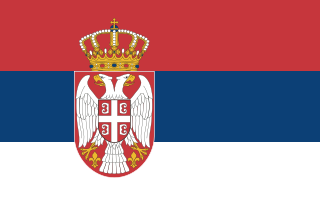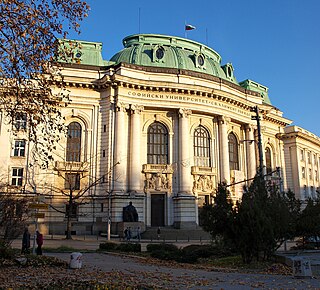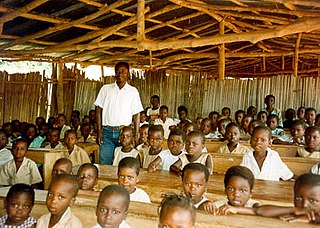
Education in Albania for primary, secondary, and tertiary levels are mostly supported by the state. The academic year is much similar to that as in the United States, classes starts almost in September or October and end in June or July. Albanian is the language of instruction in all public schools. The education takes place in three stages such as the primary, secondary, and pre-university education. There are about 5000 schools throughout the nation.
The education in Suriname was initially set up in analogy to the Dutch education system. In terms of structure, the education system is now a mixture of school types that were common in the Netherlands before, during and after the Mammoetwet. The language of instruction is Dutch; mainly Surinamese Dutch. The four exceptions to this rule are the International Academy of Suriname, administered by a local Christian foundation, Christian Liberty Academy, administered by the Caribbean Christian Ministries, and the AlphaMax Academy, a private nonsectarian school administered by the AlphaMax Foundation, and since 2011 Suriname International School, which provides k12 online school for high school students.

Education in Serbia is divided into preschool (predškolsko), primary school, secondary school and higher education levels. It is regulated by the Ministry of Education, Science and Technological Development of the Republic of Serbia.
Education in Colombia includes nursery school, elementary school, high school, technical instruction and university education.

Education in Bolivia, as in many other areas of Bolivian life, has a divide between Bolivia's rural and urban areas. Rural illiteracy levels remain high, even as the rest of the country becomes increasingly literate. Bolivia devotes 23% of its annual budget to educational expenditures, a higher percentage than in most other South American countries, albeit from a smaller national budget. A comprehensive, education reform has made some significant changes. Initiated in 1994, the reform decentralized educational funding in order to meet diverse local needs, improved teacher training and curricula, formalized and expanded intercultural bilingual education and changed the school grade system. Resistance from teachers’ unions, however, has slowed implementation of some of the intended reforms.

Education in Bulgaria is guided and overseen by Bulgarian Ministry of Education and Science. Compulsory education includes three years of pre-primary education, primary education, and secondary education. The schools start by age of seven and end the age of 18. Compulsory education at state schools is free of charge. The state and private higher education schools, colleges and universities charge fees, although they offer students scholarships.

Education in Costa Rica is divided in 3 cycles: pre-education, primary education, and secondary school, which leads to higher education. School year starts between the second and third week of February, stops at the last week of June, it continues again between the third and fourth week of July and finishes between the last week of November and the second week of December. Preschool and basic education are free to the public. Elementary and secondary school are both divided in two cycles. Since 1869, education is free and compulsory.
Education in Belarus is free at all levels except for higher education. The government ministry that oversees the running of the school systems is the Ministry of Education of the Republic of Belarus. Each of the regions inside Belarus has oversight of the education system, and students may attend either a public (state) or a private school. The current structure of the educational system was established by decree in 1994. The education system is also based on The Education Code of the Republic of Belarus and other educational standards.
Education in Kyrgyzstan is compulsory for nine years, between ages seven and 15. Following four years of primary and five years of lower secondary school, the system offers two years of upper secondary school, specialized secondary school, or vocational/technical school.
During Alfredo Stroessner Mattiauda’s presidency (1954–89), education initiatives took a backseat to economic concerns and the task of controlling political adversaries, and teacher salaries fell to extremely low levels. The constitution of 1992 attempted to remedy the long neglect of education. Article 85 of the constitution mandates that 20% of the government budget be designated for educational expenditures. This measure, however, has proven to be impractical and has been largely ignored.

Education in Dominica is compulsory from ages 5 to 16. The gross primary enrollment rate was 100.4 percent in 1991 and 98.2 percent in 1998, and the net primary enrollment rate was 88.7 percent in 1991 and 88.8 percent in 1998. Primary school attendance rates were unavailable for Dominica as of 2001. Poor physical conditions in many primary schools affect the quality of education, while some schools are overcrowded, limiting access to primary education, particularly for children living in urban areas around the capital. Poverty and work on family banana farms during the harvest season can affect school attendance, but other employment does not pull minors out of school. There is a significant Carib Indian population in Dominica, and schools on the Carib Territory are reported to have fewer resources.

Education in Honduras is essential to the country of Honduras, for the maintenance, cultivation, and spread of culture and its benefits in Honduran society without discriminating against any particular group. The national education is secular and founded on the essential principles of democracy, inculcating and fomenting strong nationalist sentiments in the students and tying them directly to the economic and social development of the nation. Honduras's 1982 Constitution guarantees the right to education, a right also conveyed through the National Constituent Assembly's Decree 131 and in the official daily publication La Gaceta.

Education in St. Lucia is primarily based on the British education system and is provided in public and private schools.
The Ecuadorian Constitution requires that all children attend school until they achieve a “basic level of education,” which is estimated at nine school years.

Benin has abolished school fees and is carrying out the recommendations of its 2007 Educational Forum. In 2018, the net primary enrollment rate was 97 percent. Gross enrollment rate in secondary education has greatly increased in the last two decades, from 21.8 percent in 2000 to 59 percent in 2016, 67.1 percent in the case of males and 50.7 percent for females. Because of a rapid increase in the enrollment rate, the student/teacher ratio rose from 36:1 in 1990 to 53:1 in 1997 but has dropped again in the last years to 39:1 (2018). In 2018, the gross enrollment ratio in tertiary education was 12.5%.
Education in Lesotho has undergone reforms in recent years, meaning that primary education is now free, universal, and compulsory.

Education in Niger, as in other nations in the Sahelian region of Africa, faces challenges due to poverty and poor access to schools. Although education is compulsory between the ages of seven and fifteen, with primary and secondary school leading into optional higher education, Niger has one of the lowest literacy rates in the world. With assistance from external organizations, Niger has been pursuing educational improvement, reforming how schools utilize languages of instruction, and exploring how the system can close gender gaps in retention and learning.
Education in Eswatini includes pre-school, primary, secondary and high schools, for general education and training (GET), and universities and colleges at tertiary level.
Primary school education in Fiji is compulsory, and subsidized for eight years. In 1978, the gross primary enrollment ratio was 113.5 percent, and the net primary enrollment rate was 97.7 percent. As of 2009, attendance was decreasing due to security concerns and the burden of school fees, often due to the cost of transport. In 2013, the Bainimarama government made education at the primary and secondary level in Fiji free for all students. Fiji has since achieved universal access to primary education.
Education in Tonga is compulsory for children through the end of high school. In 1995, the gross primary enrolment rate was 122.2 percent, and the net primary enrolment rate was 95.3 percent. Primary school attendance rates were unavailable for Tonga as of 2001. While enrolment rates indicate a level of commitment to education, they do not always reflect children's participation in school. 98.5% of students in Tonga attend schools while the other 2% are either living in remote areas without certain schools, such as in the Niua group, or they do not have enough funds to pay for their enrolment. There are about twenty institutions for higher education, 22 high schools, and around 95 primary schools including pre-schools in different villages around Tonga.










